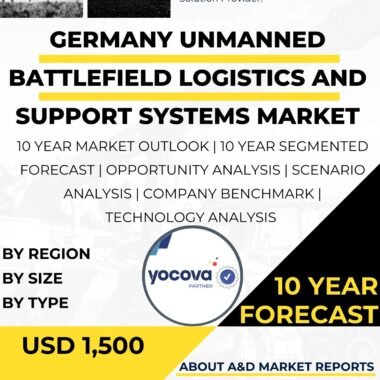Description
The unmanned battlefield logistics and support systems market in Japan has witnessed significant growth and strategic importance as the nation seeks to modernize its military capabilities, enhance operational efficiency, and reduce the risks to personnel in combat zones. Unmanned battlefield logistics and support systems are advanced technologies designed to support and streamline military logistics operations, providing Japan with a force multiplier on the battlefield.
The unmanned battlefield logistics and support systems market in Japan encompasses a diverse range of technologies, including unmanned ground vehicles (UGVs), unmanned aerial vehicles (UAVs), and autonomous supply chains. These systems are utilized by the Japan Ground Self-Defense Force (JGSDF) and other branches of the Japan Self-Defense Forces (JSDF) to enhance supply chain management, transport critical supplies, and provide real-time situational awareness in dynamic and challenging operational environments.
One of the primary applications of unmanned battlefield logistics and support systems in Japan is in improving the efficiency and effectiveness of military logistics operations. UGVs and UAVs are deployed to transport equipment, ammunition, and medical supplies, reducing the burden on human operators and increasing the speed and accuracy of supply delivery.
Moreover, autonomous supply chains play a crucial role in streamlining the flow of resources and materials in combat zones, ensuring timely and reliable support to front-line forces.
Furthermore, unmanned battlefield logistics and support systems provide Japan with a significant advantage in enhancing situational awareness. UAVs equipped with sensors and cameras offer real-time surveillance and intelligence gathering capabilities, providing commanders with valuable information on enemy movements and tactical developments.
As Japan emphasizes indigenous defense capabilities, the domestic production and development of unmanned battlefield logistics and support systems have seen substantial growth. Collaborations between the government, defense industry, and research institutions have fostered innovation, leading to the creation of state-of-the-art unmanned systems tailored to Japan’s specific operational requirements.
The unmanned battlefield logistics and support systems market in Japan also benefits from advancements in artificial intelligence (AI), robotics, and communication technologies. Manufacturers have leveraged these developments to create unmanned systems with improved autonomy, communication capabilities, and adaptability, making them more effective and reliable in complex battlefield scenarios.
However, the unmanned battlefield logistics and support systems market in Japan also faces challenges related to cost, technology integration, and operational integration. Developing and deploying advanced unmanned systems can be costly, requiring efficient resource allocation and long-term planning.
Moreover, integrating unmanned systems seamlessly into existing military operations and command structures requires careful consideration and training. Ensuring interoperability between manned and unmanned systems is crucial for maximizing the effectiveness of unmanned battlefield logistics and support operations.
Additionally, addressing cybersecurity challenges is essential for safeguarding the communication and data transmission of unmanned systems, protecting them from potential cyber threats and ensuring the integrity of critical military information.
In conclusion, the unmanned battlefield logistics and support systems market in Japan has witnessed significant growth and strategic importance, driven by the nation’s focus on modernizing its military capabilities, enhancing operational efficiency, and safeguarding personnel in combat zones. Unmanned battlefield logistics and support systems provide critical solutions for military logistics, supply chain management, and situational awareness, catering to Japan’s specific defense requirements. The collaboration between the government, defense industry, and research institutions fosters innovation and contributes to the growth of the domestic unmanned systems market. Addressing challenges related to cost, technology integration, operational interoperability, and cybersecurity is crucial for further enhancing Japan’s unmanned battlefield logistics and support capabilities and ensuring that its defense forces have access to advanced and reliable unmanned systems to support military operations, enhance logistics support, and contribute to the nation’s operational excellence and safety. With its strategic focus on indigenous defense capabilities and technological innovation, Japan remains committed to leveraging advanced unmanned battlefield logistics and support technologies to enhance military capabilities, safeguard personnel, and contribute to regional and global peace and security.




